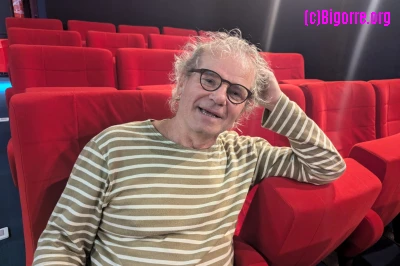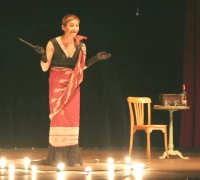We arrive in Lalanne-Trie, a village with 109 inhabitants at the last census, located a few kilometers from Trie-sur-Baïse, which has barely ten times that number. Is this it? Yes, yes, there it is, like a UFO, sitting in the middle of the village, the famous Lalano, proudly displaying "Maison de la communication" on one side and "Cinema Le Lanano" on the other. The famous Lalano, with its large auditorium seating nearly 300 and its 12-meter by 7-meter stage. The one that sends its film programming throughout the department and radiates from the outskirts of Tarbes to Magnoac and beyond. We meet Renan Le Quentrec, the official "cultural animator" with a striped sweater that emphasizes that he is alone aboard the cultural vessel. No doubt the effect of his Breton roots. How did this Lalano come about in a very rural area?
It opened in 1993. It was first and foremost a project of the residents of Lalanne-Trie who wanted it to exist. The mayor at the time turned this desire of the residents into a political one. I imagine he gathered the subsidies, and it was the residents who built the building. Yes, I didn't arrive until 2007.
How do you run a cultural venue in a very large, but not very populated area?
We program for a wide audience. At the cinema, I create a program with films that people want to see, with films that will interest moviegoers. I respect the rules that a cinema classifies as arthouse to obtain the corresponding funding. I know what interests them, what moves them. Especially the subjects that speak to them.
And what about live performance? It's the same, we're always looking for a show where 80% of people will leave with a smile on their face. There's also the programming we host, like Le Parvis, which schedules shows here like Leïla Martial in April, or the Festival Contes en Hiver organized by the Ligue de l'enseignement des Hautes-Pyrénées. I make suggestions to the association that runs the venue with the mayor and residents, who volunteer their time for Lalano.
I also saw in your program that there will also be a photography exhibition
Yes, we did a youth workshop last July with Jean-Claude Larrieu as our guiding figure. He's a very renowned director of photography who was born a few kilometers from here. He's worked with Almodóvar, Pialat, and Isabel Coixel, with whom he'll be shooting a series in Paris in a few weeks. Photographer Gabrielle Gayraud, who lives in Trie, had the young people work on portraits. This resulted in a series of portraits of residents of the Les Rives du Pélam nursing home. It's currently being printed and will soon be exhibited. The photos will also be projected on a big screen during the opening act.
Who does Lalano reach?
There's a young audience with a school program. There's the general public, which is a bit aging. And there's a gap in between because young people are leaving the area for their studies. There's no high school and nothing after that. We have more and more subscribers who come and come back regularly to see a film. And when we have a show, they're there too.
What do you want to do with Lalano?
The organization decides the direction. I want to take the programming further and do more collaborations with other venues. But I can't do everything alone: welcome the audience here, manage Le Lalano, handle communications, welcome the artists, lighting, sound, and everything else that goes with the shows. We'd need another host to go further.
Coming soon to Le Lalano
Sunday, October 13 at 5 p.m.: The Rundinelle duo offers a journey through sound memory composed of a cappella songs they recorded in the mountains and countryside of Portugal and Corsica.
Friday, November 29 at 8:30 p.m.: Clown Ludor Citrick offers a farce of the moment and place, tailor-made for Le Lalano, its audience, and its territory.

